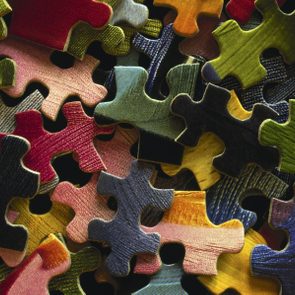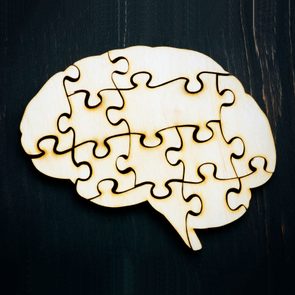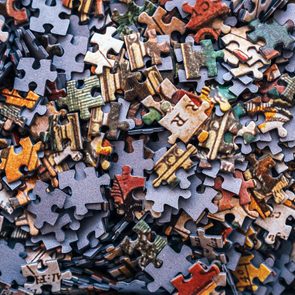Here’s Why Jigsaw Puzzles Are Good for Your Brain
Updated: Feb. 07, 2023
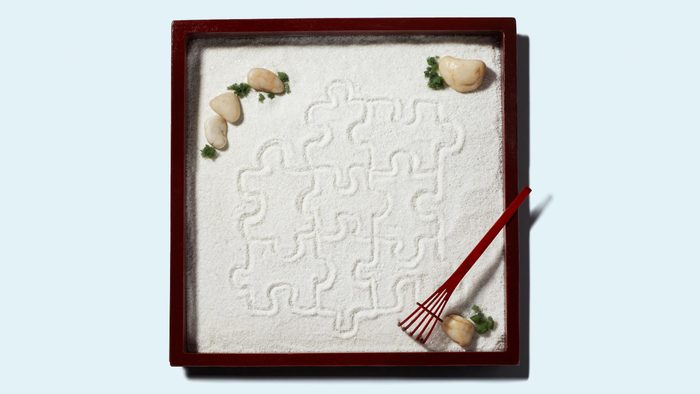
Jigsaw puzzles aren’t just fun. They can also relieve anxiety, especially when you put them together, well, together.
While out shopping for Christmas presents in 2018, I bought myself a jigsaw puzzle on a whim. It was an unusual buy, one that I now recognize as an attempt at dealing with that particular stress many of us experience during the holidays. Don’t get me wrong—I love seeing my family. But holiday get-togethers have a way of putting any personal shortcomings at center stage. This cheery pink puzzle had everything I felt I needed to distract myself in one box. And at $20, the price was right. Why not?
As soon as I started on my puzzle, I knew I’d found exactly what I was looking for. Instead of my usual late-night Netflix binge, I was sorting its 1,000 pieces well into the wee hours. I finished it in just a few days. I felt possessed by the soothing, methodical action, almost like I’d been hypnotized or spent hours meditating.
Robyn Breen, a dance instructor at Misfitstudio in Toronto, Canada, knows the feeling. At a family gathering years ago, Breen was reintroduced to puzzles and fell in love with its soothing effect. “I thought, Whoa, I feel really good when I’m doing this. I feel really chill,” she recalls. Breen suffers from anxiety, and when she was having worrisome thoughts about an upcoming trip to Nicaragua, she turned to puzzling instead of prescription medication. It worked, and jigsaws have since become an essential part of her daily routine.
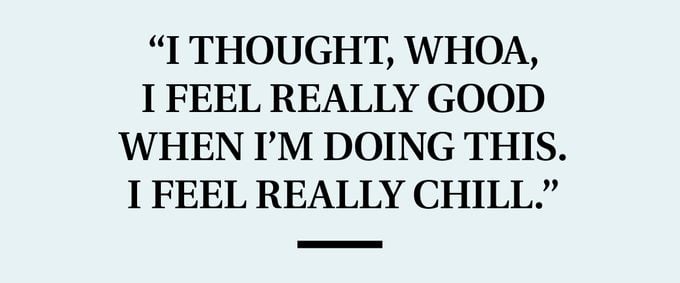
Susan Vandermorris is a clinical neuropsychologist at Toronto’s Baycrest Health Sciences, a global leader in brain health and aging research. Any type of puzzle is good for the brain and points to the stress-relieving benefits of jigsaws, in particular, she says. “If you’re doing a puzzle, you are, by definition, disconnected and engaged in a task that’s immersive, away from the interruptions and stresses of day-to-day life,” she explains. “And that, of course, is good for your brain.”
Vandermorris believes that doing puzzles with others boasts even more health benefits than doing them on your own, adding that it provides a rare opportunity for intergenerational engagement. “Get the teenagers off their smartphones and working on a puzzle with Grandma, and suddenly you’ve got a really nice family interaction that seems to be harder and harder to come by these days,” she adds.
Interaction was certainly hard to come by for Jack Brait. The 23-year-old from Marshfield, Massachusetts, has autism and first took to puzzles as a kid because they “gave him a break from the demands of socializing,” says his mom, Michele Brait, who soon realized her son had a remarkable ability. “He could complete a 1,000-piece puzzle in one sitting,” she recalls.
As Jack grew, so did his puzzling talent—and its benefits. In 2014, while still in high school, he completed a 32,256-piece puzzle (then the largest in the world) and was inducted into the Ravensburger Largest Puzzle Hall of Fame. Three years later, he tackled another behemoth: 40,320 pieces. Last year, he finished a 52,110-piecer.
Jack completed these puzzles by himself, but what used to be an escape from socializing now facilitates it. His oversized works attract attention, and he is more than willing to share the spotlight. “When I completed my first giant puzzle, I invited friends and family,” he says. “I enjoy doing them around other people.” But the best is when one of his puzzles is put on public display, as Jack likes to donate his handiwork. That, he says, makes him feel “unbelievable, proud, and happy.”
















